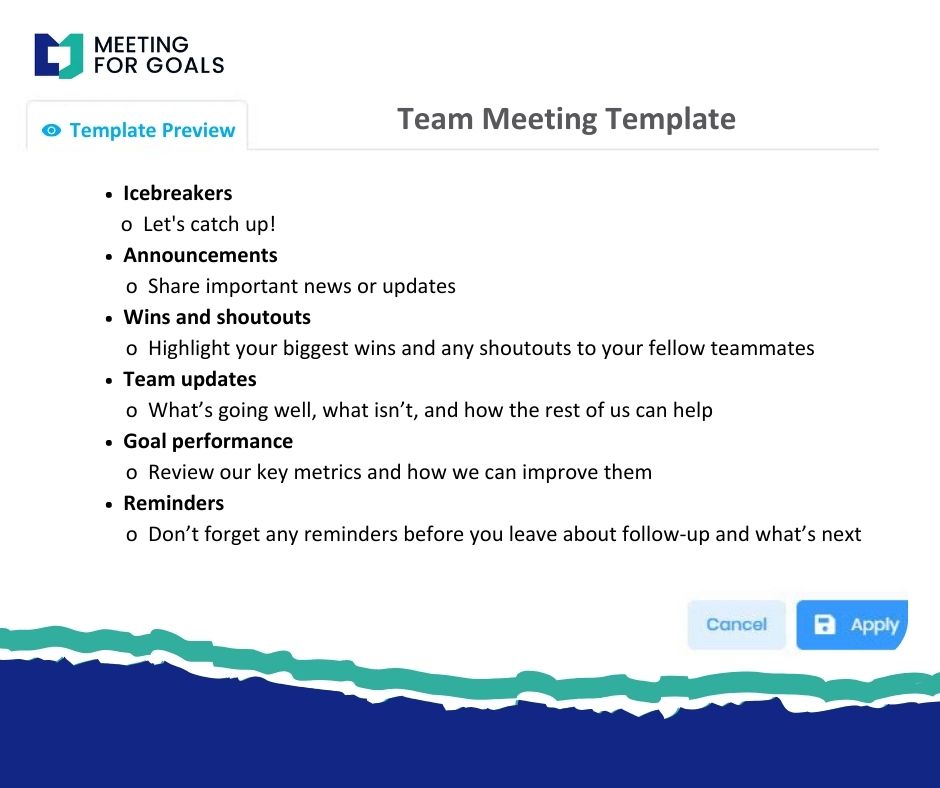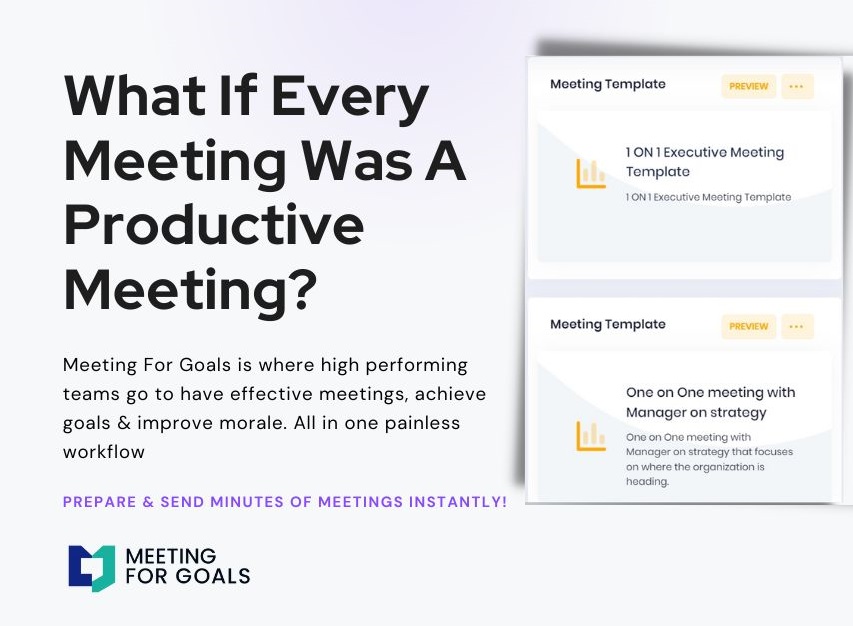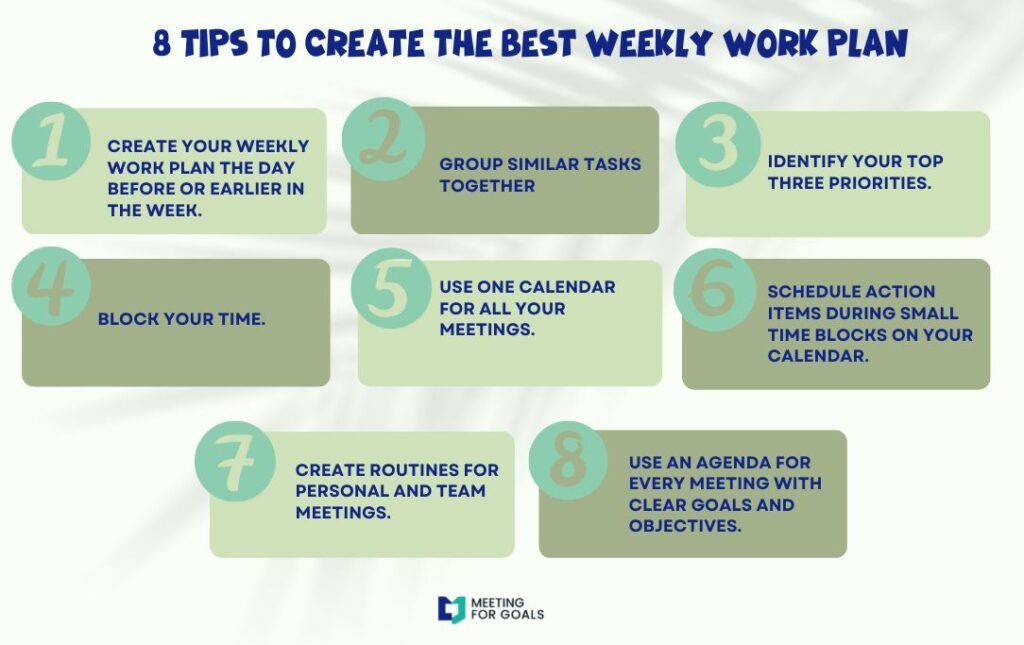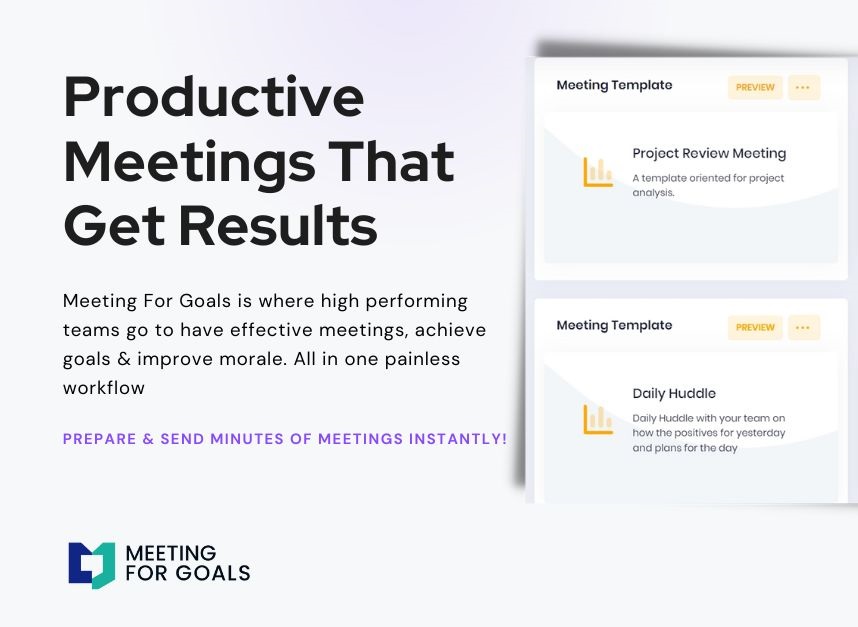Characteristics of Management for Effective Meetings
Excerpt:
In today’s fast-paced business world, meetings can either be a powerful tool for progress—or a frustrating time sink. For companies with 40 to 70 employees, especially those led by Directors, VPs, and C-suite executives, how meetings are managed can make or break team productivity. That’s why understanding the key characteristics of effective management is essential. At Meeting For Goals, we believe that successful meetings start with strong leadership. Our platform helps teams align meetings with company objectives, streamline communication, and save time. In this article, we’ll explore the essential traits of effective management and how they lead to better, more productive meetings.
Ready to transform your meetings? Start by signing up today at https://app.meetingforgoals.com/TenantRegistration/Register and explore our free meeting templates at https://meetingforgoals.com/meeting_templates to get started.
I. Introduction
In any organization, management sets the tone for how teams operate—and that includes how they meet. For mid-sized teams of 40 to 70 employees, effective meetings are a cornerstone of collaboration, innovation, and execution. But not all meetings are created equal.
Poorly run meetings waste time and drain morale. On the other hand, productive meetings drive alignment, spark ideas, and move projects forward. The difference? It often comes down to the characteristics of the manager leading the meeting.
At Meeting For Goals, we’ve worked with hundreds of teams to help them run better meetings. Our meeting management software is designed to empower leaders to align meetings with strategic objectives, improve accountability, and keep discussions focused.
In this article, we’ll break down four key management traits that lead to better meetings:
- Goal Orientation
- Communication Skills
- Decision-Making Ability
- Time Management
We’ll also show how Meeting For Goals supports each of these areas, and how you can start improving your own meetings today.
2 Minute Video
Watch a 2 minute demo of our meeting management software in action
II. Goal Orientation
Great managers are goal-setters. They don’t hold meetings just for the sake of it—they make sure every meeting has a clear objective.
Goal orientation means aligning every meeting with a bigger picture. Meetings should be steps toward goals like:
- Improving customer satisfaction
- Launching a new product
- Increasing sales
Here’s how goal-oriented managers run more effective meetings:
- Define the Purpose:
Before sending a calendar invite, ask yourself: What’s the outcome we’re aiming for? Is it making a decision, solving a problem, or sharing updates? - Build an Agenda That Reflects Goals:
Each agenda item should tie back to a specific goal. For example, if you’re aiming to reduce churn, your agenda might include reviewing customer feedback, analyzing support tickets, and discussing retention strategies. - Assign Ownership:
Every topic should have a point person responsible for updates or follow-up. This prevents ambiguity and boosts accountability. - Use SMART Goals:
SMART stands for Specific, Measurable, Achievable, Relevant, and Time-bound. These types of goals make it easier to track progress and hold teams accountable.
Meeting For Goals makes goal alignment easy. With our platform, you can:
- Set meeting goals directly in the agenda
- Link goals to company-wide objectives
- Track progress over time
This ensures that every meeting is not just a conversation—but a productive step toward your company’s success.
Want to see how goal alignment works in action? Check out our free meeting templates at https://meetingforgoals.com/meeting_templates.
Adding an Agenda
How to add an agenda instantly on Meeting For Goals
III. Communication Skills
Strong communication is the backbone of any successful meeting. Managers who communicate clearly and listen actively create an environment where team members feel heard and valued.
Here’s what effective communication looks like in meetings:
- Clarity: Speak in simple, direct language. Avoid jargon and make sure everyone understands the topic at hand.
- Active Listening: Give your full attention to the speaker. Nod, ask follow-up questions, and summarize what you’ve heard. This shows respect and ensures understanding.
- Constructive Feedback: Encourage open dialogue. Offer feedback that’s helpful, not harsh. Create a space where people feel safe sharing ideas.
- Inclusivity: Invite quieter team members to contribute. Use round-robin formats or ask for written input beforehand to make sure all voices are heard.
At Meeting For Goals, we’ve built features that support better communication:
- Collaborative Agendas: Let team members contribute to the agenda before the meeting
- Comment Threads: Add notes or questions to agenda items for asynchronous discussions
- Meeting Summaries: Automatically generated summaries ensure everyone leaves the meeting with the same understanding
These tools help reduce confusion, keep everyone on the same page, and foster a culture of transparency.
Want to learn more about how communication affects team performance? Harvard Business Review offers a great breakdown on the topic here: https://hbr.org/2016/01/the-secrets-of-great-teamwork.
IV. Decision-Making Ability
Meetings aren’t just for talking—they’re for making decisions. Whether it’s choosing a vendor, approving a budget, or setting timelines, decisions drive progress.
Great managers know how to guide teams through decision-making. Here’s how:
- Analytical Thinking: Look at the data. Consider the pros and cons. Ask the right questions to get to the root of the issue.
- Confidence: Even in uncertain situations, leaders must be decisive. Confidence builds trust and keeps the team moving forward.
- Inclusiveness: The best decisions come from diverse perspectives. Encourage input from all relevant stakeholders before making a call.
- Follow-Through: A decision is only valuable if it’s implemented. Make sure someone is assigned to carry out the decision—and that there’s a deadline.
Meeting For Goals helps streamline decision-making with:
- Action Item Tracking: Assign tasks with owners and deadlines right from the meeting
- Decision Logs: Keep a record of what was decided and why, so there’s no confusion later
- Voting Tools: Use built-in polls to gather input quickly and make collective decisions
Need help making better decisions faster? The MIT Sloan Management Review has an insightful article on decision-making in high-performing teams: https://sloanreview.mit.edu/article/decision-making-for-organizations/.
V. Time Management
Time is money—and nowhere is that more true than in meetings. A poorly run one-hour meeting with 10 people wastes 10 hours of company time.
Effective managers know how to keep meetings short, focused, and productive. Here’s how:
- Set a Clear Agenda: A good agenda is your roadmap. It keeps the conversation on track and prevents rabbit holes.
- Start and End on Time: Respect your team’s time. Starting late or running over can derail everyone’s day.
- Keep It Short: Not every meeting needs to be an hour. Can it be done in 30 minutes? Or even 15? Be ruthless about cutting fluff.
- Avoid Redundancy: If something has already been discussed via email or Slack, don’t rehash it. Use meeting time for topics that truly need live discussion.
Meeting For Goals includes powerful time-saving features:
- Time-Boxed Agendas: Allocate time limits to each agenda item
- Meeting Timers: Keep discussions on track with visible timers
- Recurring Templates: Save time planning by using templates for weekly check-ins, project updates, and more
Time management isn’t just about efficiency. It’s about respect—for your team, your goals, and your leadership role.
If you’re ready to stop wasting time in meetings, sign up now at https://app.meetingforgoals.com/TenantRegistration/Register and start using our proven templates.
VI. How Meeting For Goals Supports Effective Management
Let’s face it—managing meetings is hard. Between setting agendas, tracking decisions, and following up on action items, it’s easy to drop the ball.
That’s where Meeting For Goals comes in.
Our platform is built to support the four key characteristics of effective management:
- Goal Orientation: Connect every meeting to your company’s strategic objectives
- Communication: Use collaborative agendas, comment threads, and summaries to keep everyone aligned
- Decision-Making: Track decisions, assign tasks, and use polls to make faster, better choices
- Time Management: Use timers, templates, and time-boxed agendas to run shorter, more focused meetings
Whether you’re leading a department or an entire company, Meeting For Goals gives you the tools to lead with clarity and purpose.
Want to see how it works? Visit https://meetingforgoals.com and explore the features that are helping teams across industries save time and drive results.
VII. Conclusion
Meetings don’t have to be a waste of time. With the right management approach—and the right tools—they can become one of your team’s most valuable assets.
Let’s recap the key traits of effective management that lead to better meetings:
- Goal Orientation ensures meetings are purposeful and aligned with business objectives
- Communication Skills foster clarity, collaboration, and inclusiveness
- Decision-Making Ability turns talk into action
- Time Management ensures meetings are efficient and respectful of everyone’s time
Meeting For Goals is here to help you put these principles into practice. From agenda planning to follow-up tracking, our platform is designed to support high-performing teams.
If you’re a Director, VP, or executive looking to boost your team’s productivity, it’s time to rethink how you manage meetings.
Ready to take the next step? Sign up today at https://app.meetingforgoals.com/TenantRegistration/Register and start leading meetings that matter.
Want a head start? Explore our free meeting templates at https://meetingforgoals.com/meeting_templates and see how top-performing teams structure their meetings for success.
Don’t let another week go by with unproductive meetings. Visit https://meetingforgoals.com and discover how to meet with purpose, clarity, and impact—every time.
Word Count: Approximately 2,100 words.




